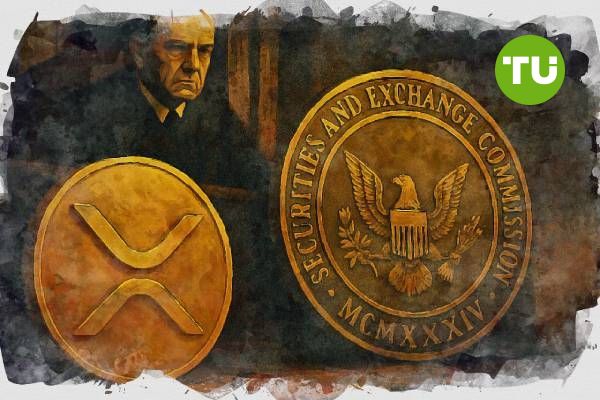XRP lawsuit theory: Why SEC sued Ripple Labs
 XRP lawsuit theory
XRP lawsuit theory
The SEC case against Ripple Labs is one of the most discussed topics in the cryptocurrency market. While it seems that the lawsuit was filed solely to protect investors, there are theories that question this narrative. What if the lawsuit itself was part of a broader strategy aimed at protecting traditional financial institutions and preserving their massive profits from high transaction fees?
XRP as a threat to traditional finance
XRP, being one of the leading players in the world of cryptocurrencies, has been striving since its inception to improve the transaction system by offering a solution that is significantly cheaper and faster than traditional banking systems. Specifically, Ripple's technologies and the XRP token could significantly reduce the costs of international transfers. At the time, XRP facilitated cross-border transactions amounting to about $70 billion each quarter, with each transaction costing just a few cents. This economic efficiency sharply contrasted with traditional SWIFT bank transfers, which charged fees ranging from $20 to $50 per transaction, often accompanied by delays in settlement that could last several days.
The role of banks in high transfer fees
The banking system and financial institutions traditionally earn revenue from fees charged for international transfers and transactions. These fees can be quite high and represent a significant source of income for banks around the world. However, with the development of blockchain technologies and cryptocurrencies like XRP, the banking business faces a threat: cryptocurrencies can significantly reduce fees and speed up transaction times.
Loading...
Looking at the current situation from a broader perspective, it becomes clear that banks are not interested in losing their income from these fees. This is why they may perceive cryptocurrencies as a threat to their business. According to some experts, this could be the motive behind the lawsuit filed against Ripple: to protect the current system of international payments, where financial institutions play a key role, from potential multi-billion-dollar losses.
Time of the lawsuit and possible connection with financial institutions
A post on X from the well-known crypto expert under the pseudonym All Things XRP sheds light on an interesting theory: perhaps the SEC's lawsuit was not only filed to comply with regulatory standards but also to protect financial institutions, such as banks and SWIFT, from the threat posed by XRP's rapid scaling.
The SEC accused Ripple of selling XRP illegally, classifying the cryptocurrency as a security. Ripple, in turn, argued that XRP is a digital asset, not a security, and that cryptocurrency regulation should follow different principles than traditional financial instruments.
It is important to note that the lawsuit was filed just days before the resignation of SEC Chairman Jay Clayton, who had close ties to major financial institutions, including Goldman Sachs and JPMorgan. As the commentator points out, such connections may have played a key role in the decision to file the lawsuit against Ripple at this critical moment.
In 2020, when the SEC filed the lawsuit against Ripple, the price of XRP dropped by 66% in a single day, leading to the loss of crucial business partnerships and the removal of the asset from several exchanges. This halted Ripple's progress, which was already showing growth and attracting the attention of major financial market players.
For instance, MoneyGram, Ripple's partner for international transfers, suspended its use of XRP shortly after the lawsuit was filed. At the same time, SWIFT began exploring blockchain technologies to improve its operations, which, according to the commentator, could have been a direct consequence of the legal pressure on Ripple.
Loading...
This theory also raises the question of why XRP faced such scrutiny from the SEC, while similar projects, such as Ethereum, experienced more lenient regulation. Unlike Ethereum, whose 2014 ICO was essentially approved by the SEC, XRP had to face harsh prosecution. This creates the impression that XRP became a target not only for investor protection, but also to safeguard the interests of major players in the financial market.
Since the lawsuit was filed, Ripple has continued to fight for its position, and although the company spent over $200 million on legal costs, its progress was not stopped. In 2023, the court ruled that XRP sales on secondary markets are not securities transactions, causing the cryptocurrency's price to rise by 73% in a single day. However, according to All Things XRP, the damage had already been done. XRP largely disappeared from U.S. trading platforms, and many financial institutions, fearing regulatory uncertainty, chose not to engage with it.
However, these events did not mark the end for XRP. On the contrary, they became a catalyst for further development.
Can the SEC’s actions save the banking system?
The answer to this question depends on many factors. However, it is important to note that the financial system has already begun to adapt to the new state of affairs. Some major banks are starting to invest in blockchain technology and even implementing their own cryptocurrency solutions to increase the efficiency of their operations. However, at the moment, traditional financial institutions are unlikely to view a threat like XRP and similar cryptocurrencies calmly.
Nevertheless, Ripple continues to develop its platform and attract new partnerships, and the cases against them have become an interesting indicator of how regulators will interact with emerging technologies in the future.
Conclusion
If the SEC’s lawsuit is indeed a means of protecting banks from significant losses on transaction fees, it raises important questions about the future of the cryptocurrency market. XRP continues to demonstrate its ability to reduce fees and speed up international transfers, and if this trend continues, banks are likely to start looking for ways to adapt to the new realities.Only time will tell if Ripple and XRP can turn the current circumstances to their advantage and rewrite the history of cryptocurrency wars, seizing leadership among altcoins.













































































































































